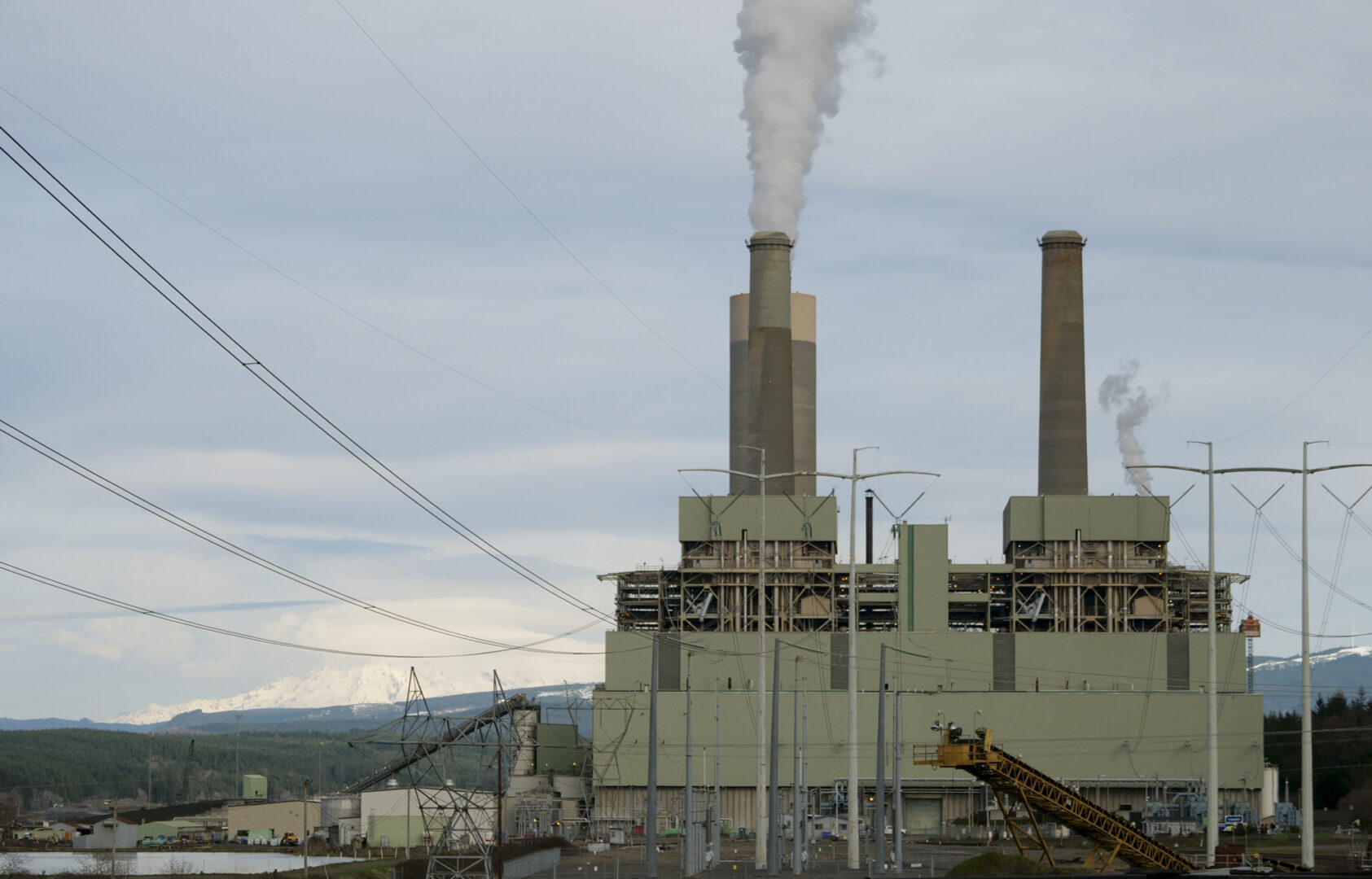
The TransAlta Centralia Generation station pictured on March 8, 2024. Mount Rainer is visible to the left of the plant. (Jeremy Long - WITF)


The TransAlta Centralia Generation station pictured on March 8, 2024. Mount Rainer is visible to the left of the plant. (Jeremy Long - WITF)

The TransAlta Centralia Generation station pictured on March 8, 2024. Mount Rainer is visible to the left of the plant. (Jeremy Long - WITF)
This story was produced as part of Climate Solutions, a collaboration focused on community engagement and solutions-based reporting to help Central Pennsylvania move toward climate literacy, resilience and adaptation. StateImpact Pennsylvania convened the collaboration; WITF is a Climate Solutions partner. Other Climate Solutions partners are Franklin & Marshall Center for Public Opinion, La Voz Latina, Sankofa African American Theatre Company, Shippensburg University, Q’Hubo News, and the York Daily Record.
Edna Fund remembers what Centralia, Washington was like in the 1960s, before the coal mine and power plant opened.
She and a friend drove to the site a few miles from the city, where they were going to college.
It was all farmland. Owners were selling their land to make way for industry.
Years later, she would visit the site again as an elected official.
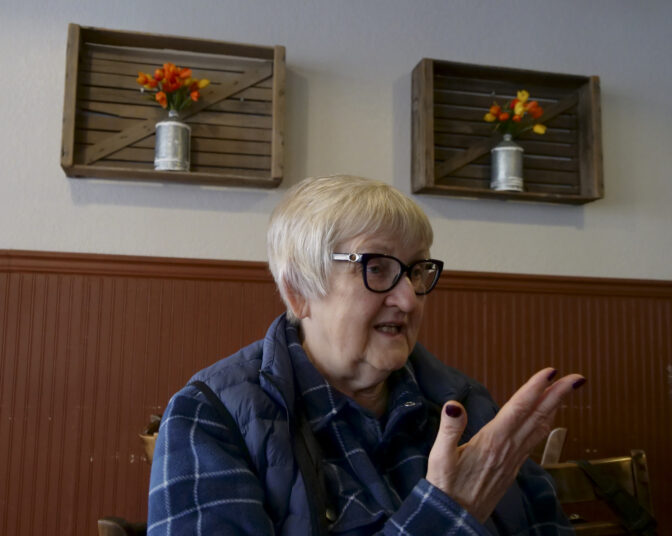
Edna Fund, a former Lewis County commissioner and Centralia city councilor, during coffee and breakfast with business owners at Dawn’s Delectables on March 8, 2024. (Jeremy Long – WITF)
“And I remember looking out at the area, like, this was farming land. And now we’re having all this coal being mined, and there’s a train coming in and out,” Fund said. “Pretty amazing to see the transformation.”
The land ultimately became a nearly 10,000-acre open pit mine with a 1,340-megawatt power plant.
It became Lewis County’s highest-paying employer, she said, and “people drove from long ways to get here to work there.”
A half-century later, climate change brought focus on polluting power plants. Environmental groups and some state lawmakers started pushing to shut down the plant. Fund was on Centralia city council at the time.
“It was packed, packed in the halls of the legislature. And you would see pipefitters and union folks up there in their uniforms. And then you’d see the environmentalists there–and they’re on two sides,” Fund said.
After a few years of lawsuits, proposals and protests, then-Gov. Christine Gregoire gathered members of each group – government, environmental, labor, and the coal company – and asked them to figure out a deal.
It took the task force only a few days to reach an agreement. The plant would close by 2025. To soften the blow, the company, TransAlta, would set up a $55 million community transition fund.
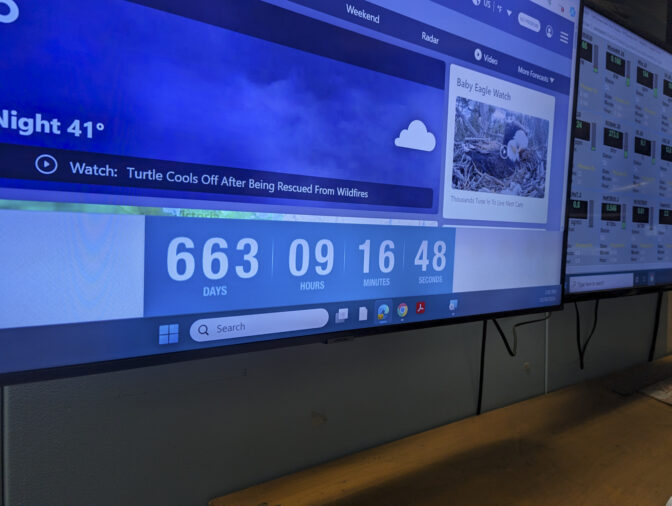
A countdown clock inside the control room of TransAlta’s Centralia Coal Plant on March 8, 2024 shows how much time is left until the plant has to close. (Jeremy Long – WITF)
Centralia – about the size of Johnstown, Pennsylvania – has now been cited as a model for how to successfully transition away from coal.
The fund didn’t change the city overnight. But it did mark Centralia as open to new ideas and opportunities.
“It’s not a soft landing, but it’s a better landing than it could have been,” Fund said.
Why StateImpact Pennsylvania went to Centralia, Wa
Bob Guenther is a member of the ‘71 club – the group of people who started working at the Centralia coal plant in 1971, when it opened. He was the second mechanic hired, and he stayed for 34 years.
As a foreman in the mid-90s, he and other employees worked with environmental groups, state government, the National Park Service and the U.S. Forest Service to decide how to lower pollution at the plant. The Associated Press reported they settled on a scrubber system to reduce sulfur dioxide emissions from 65,000 to 10,000 tons per year.
TransAlta bought the plant from Pacific Power and Light in 2000, and took on the then-estimated $200 million in costs for the upgrades.
About a decade later, environmentalists concerned with climate change were ramping up pressure to close the plant. It was the state’s largest polluter, and they blamed it for haze in and around Mount Rainier National Park, about 50 miles away.
The Chronicle, Centralia’s newspaper, reported that the coal plant emitted an annual average of 9,850,000 metric tons of carbon dioxide from 2001 to 2009, according to statistics provided by TransAlta. Those emissions equal 2.3 million gas-powered cars driven for one year.
The plant generated about 10% of the state’s power in 2011.
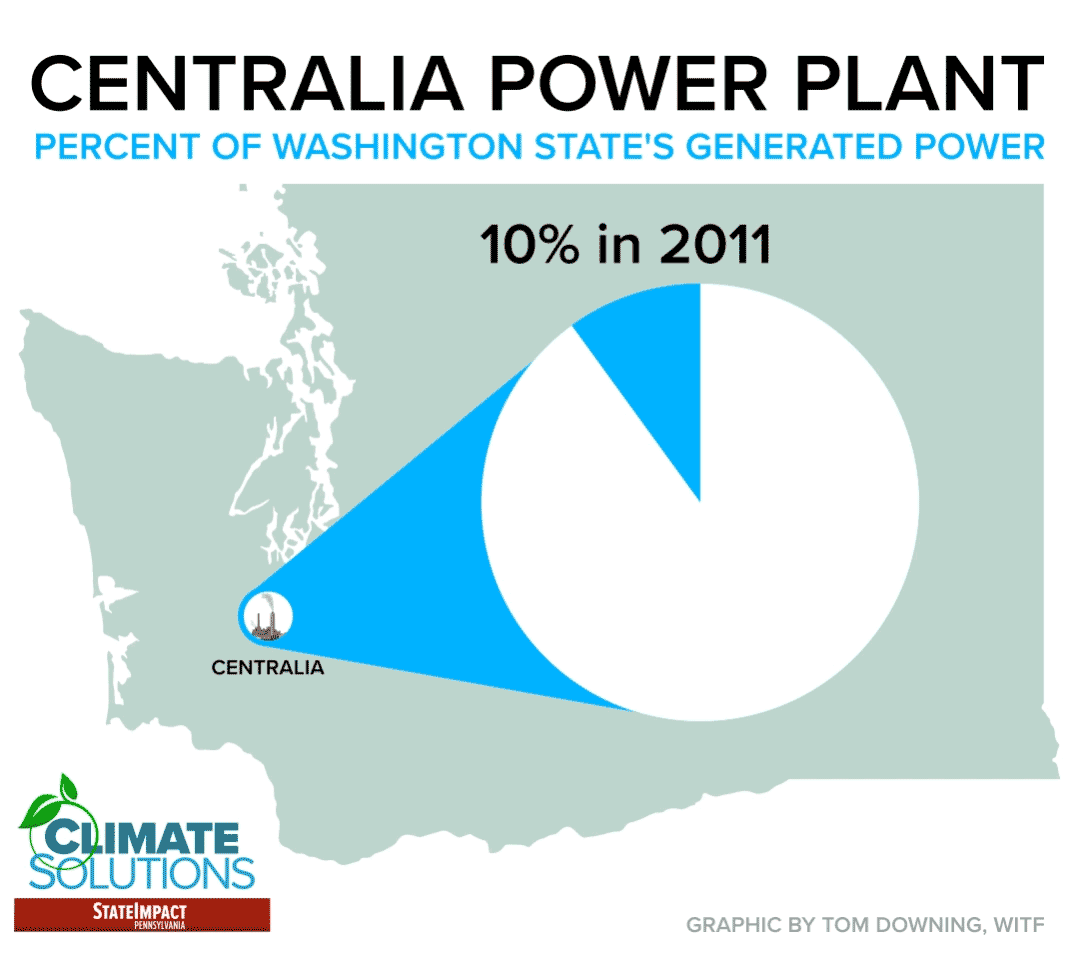
Environmentalists wanted it closed as soon as possible – 2015 at the latest.
Guenther had retired from the plant by then, but was lobbying for the International Brotherhood of Electrical Workers, which represented the roughly 300 workers at the time.
Guenther made it a point to take green groups and politicians to see “the enormity” of the plant.
“I think they left with a little better understanding of what we were trying to do,” he said. “And so from that point on, we really had some good conversations about how we were going to see if we couldn’t come to a resolution to where nobody really got hurt too bad in this shutdown.”
Guenther’s goal was to give workers and the community time and resources to get ready for whatever was next.
“I believed in our community. I believed in the workers. I believed in our government,” he said. “We believed that we could do something better than just turning the switch off.”
Guenther wasn’t in the room for the actual negotiations. But people such as Richard DeBolt, who Guenther described as a former political rival, give him a lot of credit for the final deal.
“I think the one thing you can take away from all this is you’re going to have to have local champions that stand up for your community and that are willing to do what’s right,” DeBolt said.
DeBolt was a Republican lawmaker in the state’s Democratically-controlled part-time legislature. He knew how a final vote would go.
“It was a very humbling experience. And I always will carry that with me that, you know, we were doing something to people. We weren’t doing something for people,” DeBolt said. “My community paid the price for climate change here.”
The area had suffered before. Timber took a major hit after the northern spotted owl was listed as endangered in 1990. TransAlta closed the coal mine in 2006, laying off about 600 workers.
DeBolt said the mine closure came with important lessons.
“If you take care of your employees, even if they have lost their jobs, they’ll still be faithful to the community, it won’t hurt the community economically, and those families can recover,” he said.
DeBolt took that lesson to the plant closure negotiations. He was on the task force because of his day job – director of external relations for TransAlta.

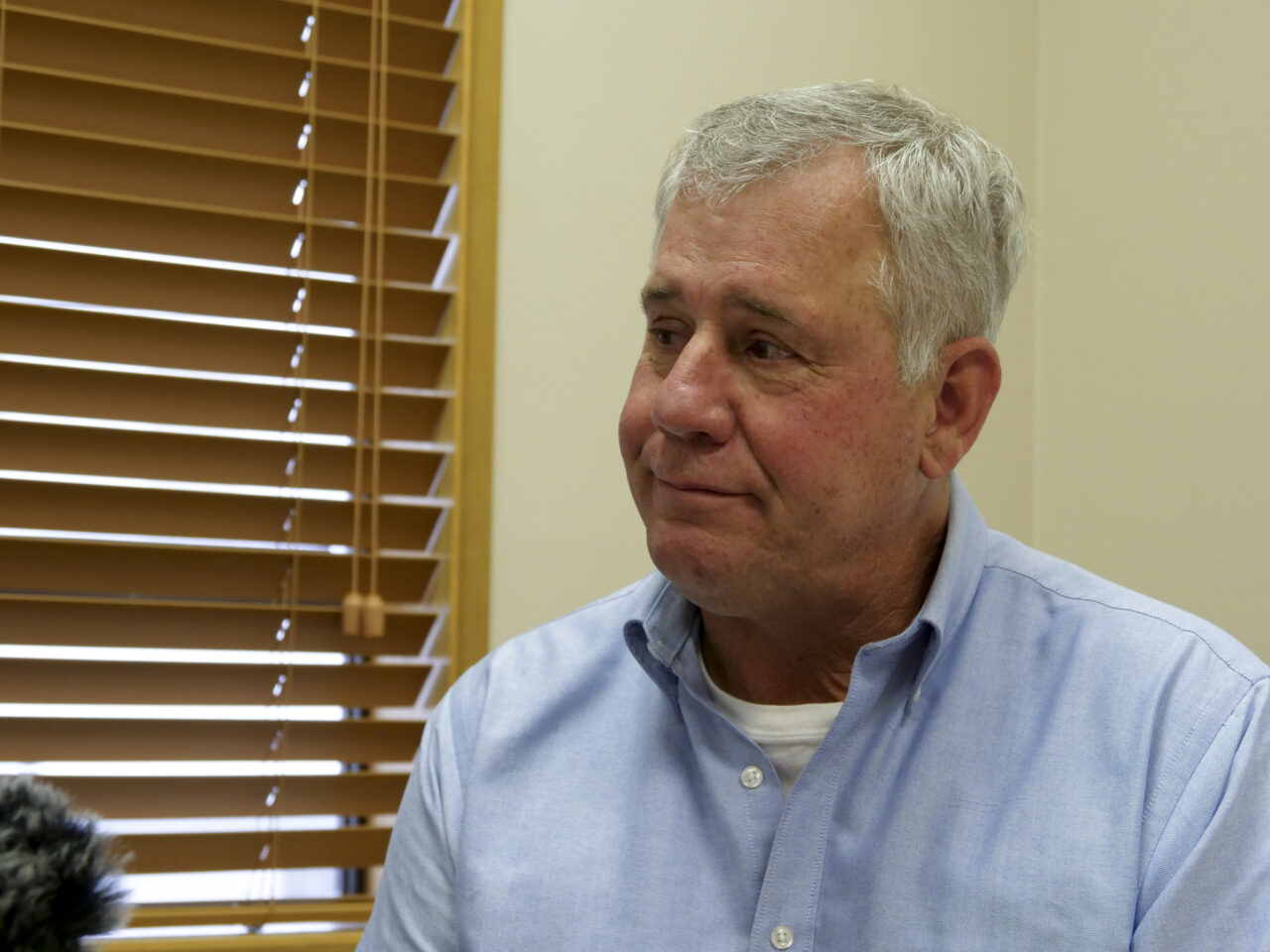
Across the table sat people like Nancy Hirsh, who was policy director at the Northwest Energy Coalition at the time. She represented more than 100 groups from utilities, environmental and civic sectors in the negotiations.
“A lot of the environmental constituents felt like, 2025? Are you kidding? That’s forever,” Hirsh said.
But she said having a set closure date gave all the parties certainty.
In the meantime, environmental groups had the victory of getting more pollution controls at the plant and money to invest in clean energy.
DeBolt said the company agreed to the deal because it allowed the plant to continue operation until 2025, and it allowed the company to keep claiming tax credits for pollution reduction efforts, such as using cleaner-burning coal from Wyoming. With that in place, TransAlta agreed to make payments into the $55 million transition fund.
“Companies, if you’re willing to work with them on their closure ramp, then they’re willing to step up and help their communities and do more,” DeBolt said. “But if you just mandate it and say, ‘give us money too,’ it’s not going to work like that, right?”
The transition fund is unusual. No such account has been announced for Pennsylvania’s remaining large coal generators, which employ around 400 people between two plants in Indiana and Armstrong counties.
In Centralia, the fund has attracted interest from some new companies, but Hirsh had hoped for more. The city still hasn’t landed one big employer that can replace TransAlta.
“I kind of had that fantasy that was going to happen,” she said, “with this economic development money, we were going to be able to bring in a bunch of new industrial companies. That’s hard and more complicated than I knew.”
TransAlta says it wants to keep supplying power to the area.
“We are open to several different technologies and fuels to make that happen, and the future will likely involve this diversity rather than single large units we’ve operated in the past,” said spokesperson Katie Duke.
It’s not clear how many jobs the company might have.
The company will have to decommission the plant, if they cannot find a way to reuse it. Reclamation work at the former mine site is ongoing. TransAlta is a part-owner in a wind energy project near the coal plant.
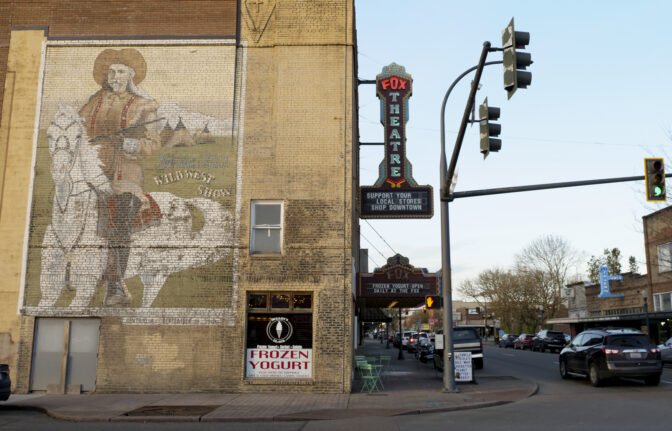
The Fox Theatre on Tower Avenue in Centralia, Washington on March 7, 2024. The theater got a weatherization grant from the Coal Transition Board to replace it’s 1930s furnace with a new and efficient heating and cooling system. (Jeremy Long – WITF)
Centralia Mayor Kelly Smith Johnston said the fund is helpful, but it’s not the only solution.
“Our problem is much bigger than that. And it takes incredible vision of what’s next, not just trying to replace what was lost,” Johnston said
There are prospects. Centralia is part of Washington’s federal hydrogen hub, powered by renewable energy. Some hydrogen companies are eyeing the area. A nuclear fusion startup is considering setting up next to the coal plant.
DeBolt, who now directs the Lewis County Economic Alliance, sees these as positives.
“Think about the evolution of this community and how impactful that is to the future for our kids. It’s kind of like we went from natural resources and fossil fuels to the future of energy and the future of fuel. It’s pretty amazing,” he said.
Some are worried there won’t be enough electricity on the grid to meet demand after the coal plant shuts down and before the new energy sources ramp up.
The North American Electric Reliability Corporation’s most recent long-term assessment found that the Northwest could be at risk of shortfalls during extreme summer heat after 2026. NERC said with expected fossil-plant retirements, there may not be enough generation that can be called up when electricity demand is high.
The Bonneville Power Administration, which oversees electric transmission in the Pacific Northwest, has been planning for the effects of the plant closure.
Spokesman Doug Johnson said the shutdown may affect congestion on the grid, meaning an overload of electricity on some lines could keep it from reaching homes. But Johnson said BPA recently added resources that should keep power flowing smoothly.
Some people worry that new industries won’t create the same quality of life as the coal plant.
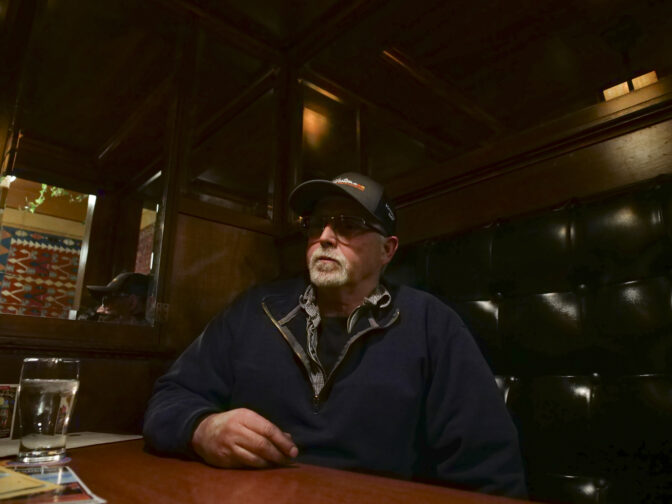
Gene Potter, seen here at McMenamin’s Olympic Club on March 6, 2024, has been a machinist at the Centralia Coal Plant for decades. He’s concerned new industries won’t offer the same wages or quality of life as the coal plant. (Jeremy Long – WITF)
Gene Potter has worked as a machinist there for more than 20 years.
“If you live in Lewis County and you’re a guy that likes to work with his hands or has a mechanical background, that is top notch the best job,” he said.
His wife was able to stay at home and raise their kids. He’s helped his kids with college. The couple own several rental properties.
He’s concerned new industries might bring only temporary construction jobs.
“Pipefitters, boilermakers are going to come in, laborers, those sort of trades. But how long is that really going to last? That’s not going to pump a ton of money,” Potter said.
As part of the fund, each worker can get $15,000 to get new training. So far, 16 employees and 10 spouses of employees have taken advantage.
But for Potter, who’s 58, going to school isn’t that appealing.
“We’re asking, can we use it to start a business or further a business? And we’re waiting to see what the answer is on that,” he said.
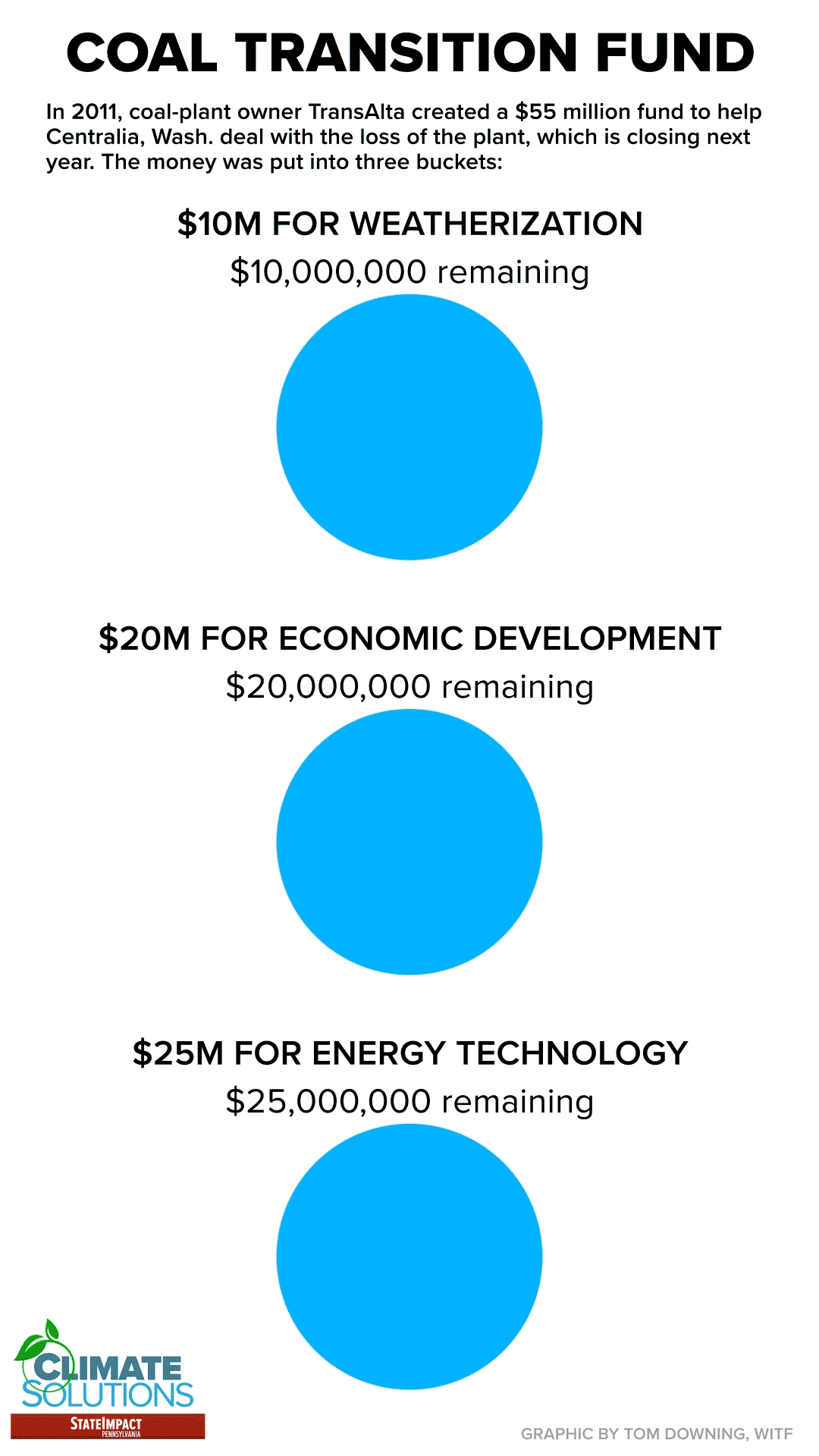
Employment at the plant has been falling gradually. One unit shut down in 2020. Now about 100 people work at the second unit, down from 300 at the whole plant a decade ago.
Because the shutdown is spread out, it doesn’t have as much of a shock as past closures.
TransAlta’s mine closure in 2006 was sudden. And it was followed by a major flood and then the Great Recession.

Levi and Sarah Althauser, seen here on March 7, 2024, applied for a grant to help them replace the roof and heating system at the Juice Box Public House in Centralia, Wash. Without the money, they said they likely would have had to give up on their idea for a new kind of community space. (Jeremy Long – WITF)
Levi Althauser, owner of the Juice Box Public House restaurant and music venue, said the coming final phase of the plant closure won’t have nearly the impact of those events.
He said jobs were slow to come back, and too many are low-paying. The U.S. Census Bureau estimates more than 20% of people in the city live in poverty, compared to 10% statewide.
But he’s encouraged to see other small businesses that have clawed their way back.
Sarah Althauser, city council member and Levi’s wife, said she hopes the attention will create a ripple effect.
“I think we have a lot of amazing momentum going on right now in our community,” she said.
TransAlta was a big source of taxes for Centralia’s school district, and donations to the community college and nonprofits.
Johnston, who moved to the area around 2000, said long-time city residents tell her the plant provided a thriving middle class.
“And what they tell me is they see that eroding now, where there’s less of a middle class in Centralia,” she said.
That has an effect on other businesses that might not be obvious at first.
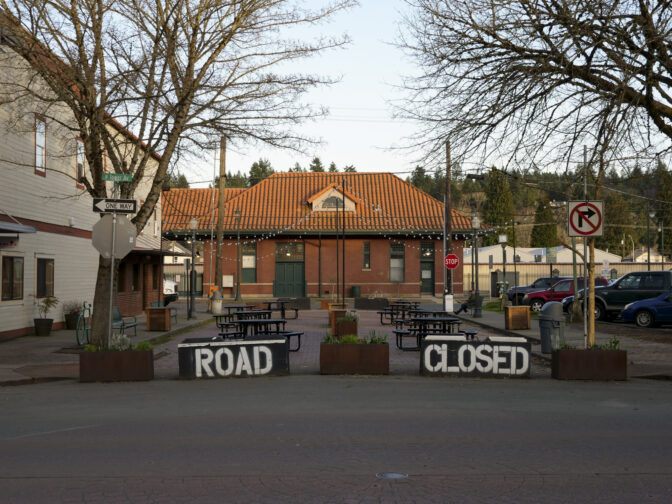
Pine Street Plaza, a project of the Centralia Downtown Association, offers the chance for events such as live music at East Pine Street and North Tower Avenue in Centralia, Washington. (Jeremy Long – WITF)
Twelve years ago, Dawn Merchant opened Dawn’s Delectables, a cafe where nearly everything is made from scratch, from soups to baked goods.
It’s a community space in downtown, but catering for employee retirement parties and other celebrations at TransAlta made up a big part of Merchant’s income.
She said that work has slowly dwindled in the last couple of years.
The city’s population is also growing and changing. It’s home to nearly 19,000 people now, compared to about 15,000 in 2000. Some people have left to find new jobs. New people are moving here from larger, more expensive cities, enabled by remote work. That creates new challenges for small businesses.

MacKenzie McGee, executive director of the Centralia Downtown Association (standing) chats with local business owners during coffee and breakfast at Dawn’s Delectables pictured on March 8, 2024. (Jeremy Long – WITF)
Rebecca Staebler opened the gift and craft boutique HUBBUB about 20 years ago. Her customer base was people in their 40s and older. Now, she said, she’s constantly trying to figure out who her customers are and what they want.
Despite the challenges, she said it’s also an exciting time for Centralia.
“We have the potential to be the place; I want to be the best little city in the state of Washington,” Staebler said.
In addition to the clean energy startups eyeing the area, new small businesses are opening.

Alliyah Perry moved to Centralia, Wash., in 2020. She started farming and opened local food store Farm+Flourish in 2023. She talks about her love of farming during coffee and breakfast with other business owners at Dawn’s Delectables as Rebecca Staebler, owner of HUBBUB gift and craft boutique, listens on March 8, 2024. (Jeremy Long – WITF)
Alliyah Perry moved to Centralia in 2020 and bought a farm, where she grows produce such as tomatoes and garlic.
Last year she opened Farm + Flourish, a local food store. She said it’s like living in a dream; she can’t imagine not farming anymore.
“That’s how much I love it. The store is going crazy. I’m going to have to hire a person so I can continue to farm,” she said.
People in town know the plant is closing and what kinds of effects it might have. But it’s not the first thing they bring up in conversation. They’re more likely to focus on what’s going well.
The community has had time to prepare–exactly what labor organizers hoped to get in negotiations about the closure.
Why we went to Centralia, Wa.
StateImpact Pennsylvania went to Centralia, Washington to look at how it prepared itself for a coal-plant shutdown, establishing a long timeline for closure and a transition fund.
It’s a different formula than in Pennsylvania, where dozens of Pennsylvania coal plants have closed in the last few decades as the Marcellus Shale boom sent a wave of cheaper natural gas into the market, making it harder for coal to compete. Some companies have decided new environmental regulations are too costly.
The Homer City plant closed last year, with 90 days notice. The handful of remaining coal plants are converting to natural gas or will close by 2028, citing the expense of complying with new wastewater regulations.
State lawmakers who want to address climate change or preserve coal jobs have been at odds.
In 2019, former Gov. Tom Wolf, a Democrat, proposed joining the Regional Greenhouse Gas Initiative–which charges power plants for their emissions. Some of the money raised would help communities that have lost energy jobs. The effort is stalled in court.
Democratic Gov. Josh Shapiro has proposed his own version of a cap-and-trade program that would be tailored to Pennsylvania, but his office hasn’t said how proceeds could be used to help energy communities.
Republicans who control the state Senate dismissed the idea.
We wanted to see if Centralia’s story could have lessons for Pennsylvania as the energy-rich state sees a decline in coal and pressure builds to contain emissions from all fossil fuel.
StateImpact Pennsylvania is a collaboration among WITF, WHYY, and the Allegheny Front. Reporters Reid Frazier, Rachel McDevitt and Susan Phillips cover the commonwealth’s energy economy. Read their reports on this site, and hear them on public radio stations across Pennsylvania.
(listed by story count)
StateImpact Pennsylvania is a collaboration among WITF, WHYY, and the Allegheny Front. Reporters Reid Frazier, Rachel McDevitt and Susan Phillips cover the commonwealth’s energy economy. Read their reports on this site, and hear them on public radio stations across Pennsylvania.
Climate Solutions, a collaboration of news organizations, educational institutions and a theater company, uses engagement, education and storytelling to help central Pennsylvanians toward climate change literacy, resilience and adaptation. Our work will amplify how people are finding solutions to the challenges presented by a warming world.